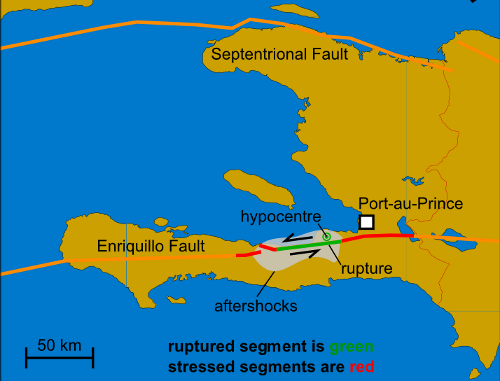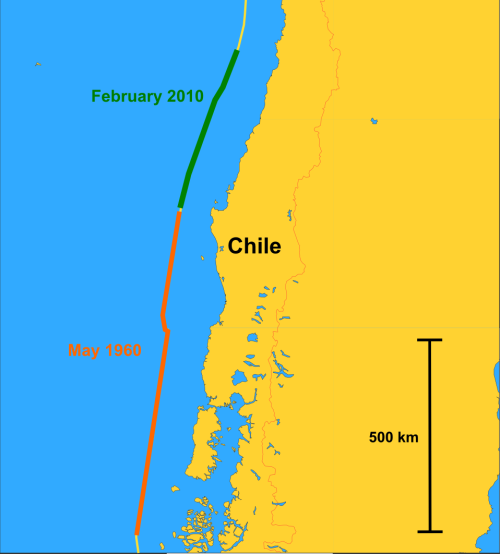![]() I’ve been invited to contribute to Haiti Rewired, Wired’s collaborative conversation about rebuilding post-earthquake Haiti. Obviously, geology – in particular, future seismic hazard – is an important consideration when making decisions about rebuilding Haiti, and ensuring that the inevitable future earthquakes are better prepared for. Anything I post there will get cross-posted (with a delay) here, but I encourage you all to go and have a look at Haiti Rewired, and see whether you can make any contributions to the discussion yourself.
I’ve been invited to contribute to Haiti Rewired, Wired’s collaborative conversation about rebuilding post-earthquake Haiti. Obviously, geology – in particular, future seismic hazard – is an important consideration when making decisions about rebuilding Haiti, and ensuring that the inevitable future earthquakes are better prepared for. Anything I post there will get cross-posted (with a delay) here, but I encourage you all to go and have a look at Haiti Rewired, and see whether you can make any contributions to the discussion yourself.
The earthquake that rocked Haiti two months ago was produced by the rupture of a roughly 50 kilometre section of the Enriquillo Fault that runs through southern Haiti. The total length of this fault system, which accommodates about half of the westward motion of the North American plate relative to the Carribean plate that occurs in this region, is several hundred kilometres. This means that on the sections of the fault adjacent to January’s rupture, the strain built up by several hundred years’ of plate motions is still there, waiting to be released. The only question is when, and how.
In fact, the recent seismic activity may have actually increased the risk of one of these neighbouring segments failing in another large earthquake. When a fault ruptures, the sudden motion stresses the surrounding crust. The aftershocks that followed the January 12th earthquake were one result of this. But the ‘surrounding crust’ includes the adjacent, unruptured segements of the Enriquillo Fault, and placing more stress on them can potentially bring these sections closer to the point where they too will fail. Modelling of the deformation resulting from January’s rupture (shown in green on the figure below) indicates that the largest stress increase (red) has been on the 50 km section immediately to the east, with a significant but smaller increase on a 20 km section just to the west.

The increased stress on these parts of the fault potentially mean that they will rupture sooner rather than later. This is of particular concern for the eastern fault section, which runs only a few kilometres to the south of Port-au-Prince. This is so close that even a moderately large earthquake could do a lot of damage (the actual shaking intensity due to an earthquake is strongly dependent on the distance from the rupture point, as well as the total energy released).
Of course, in geological terms, ‘soon’ does not necessarily mean next month, or even next year. To take a topical example, in May 1960 the largest earthquake ever recorded, with a magnitude of 9.5, was the result of a rupture almost 1000 km long on the subduction thrust off the west coast of Chile. This placed more stress on the fault segment immediately to the north, which eventually ruptured. Fifty years later.

In contrast, stresses induced by the magnitude 9.1 earthquake that occurred off the coast of Indonesia in December 2004 probably contributed to the rupture of a neighbouring section of the Sunda Trench in a magnitude 8.7 earthquake a mere 4 months later. The problem is that the effect of these additional stresses depends on how close a particular part of the fault is to failing already. If it is already quite close to the point of failure, adding a bar or two of additional stress may push it right to the brink of rupturing or beyond; if not, then the additional loading will not have such an immediate effect. How do you tell the difference? Not very easily, although hopefully collecting data on current and recent deformation around the Enriquillo Fault, through close study of comparative radar imagery (several examples are available here) and new GPS data might provide some clues. More detailed study of the historical activity of the Enriquillo Fault – how large past ruptures were, and how activity on adjacent sections was correlated – might also provide some insight into the possible seismic future.


 Note: This is a guest blog post from Will Dalen Rice, a graduate student in the
Note: This is a guest blog post from Will Dalen Rice, a graduate student in the 

Nice plan for content warnings on Mastodon and the Fediverse. Now you need a Mastodon/Fediverse button on this blog.